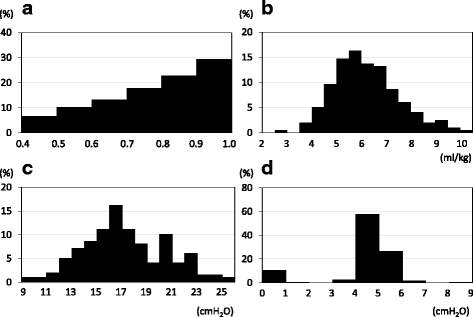Associations between intraoperative ventilator settings during one-lung ventilation and postoperative pulmonary complications: a prospective observational study
- PMID: 29370755
- PMCID: PMC5785851
- DOI: 10.1186/s12871-018-0476-x
Associations between intraoperative ventilator settings during one-lung ventilation and postoperative pulmonary complications: a prospective observational study
Abstract
Background: The interest in perioperative lung protective ventilation has been increasing. However, optimal management during one-lung ventilation (OLV) remains undetermined, which not only includes tidal volume (VT) and positive end-expiratory pressure (PEEP) but also inspired oxygen fraction (FIO2). We aimed to investigate current practice of intraoperative ventilation during OLV, and analyze whether the intraoperative ventilator settings are associated with postoperative pulmonary complications (PPCs) after thoracic surgery.
Methods: We performed a prospective observational two-center study in Japan. Patients scheduled for thoracic surgery with OLV from April to October 2014 were eligible. We recorded ventilator settings (FIO2, VT, driving pressure (ΔP), and PEEP) and calculated the time-weighted average (TWA) of ventilator settings for the first 2 h of OLV. PPCs occurring within 7 days of thoracotomy were investigated. Associations between ventilator settings and the incidence of PPCs were examined by multivariate logistic regression.
Results: We analyzed perioperative information, including preoperative characteristics, ventilator settings, and details of surgery and anesthesia in 197 patients. Pressure control ventilation was utilized in most cases (92%). As an initial setting for OLV, an FIO2 of 1.0 was selected for more than 60% of all patients. Throughout OLV, the median TWA FIO2 of 0.8 (0.65-0.94), VT of 6.1 (5.3-7.0) ml/kg, ΔP of 17 (15-20) cm H2O, and PEEP of 4 (4-5) cm H2O was applied. Incidence rate of PPCs was 25.9%, and FIO2 was independently associated with the occurrence of PPCs in multivariate logistic regression. The adjusted odds ratio per FIO2 increase of 0.1 was 1.30 (95% confidence interval: 1.04-1.65, P = 0.0195).
Conclusions: High FIO2 was applied to the majority of patients during OLV, whereas low VT and slight degree of PEEP were commonly used in our survey. Our findings suggested that a higher FIO2 during OLV could be associated with increased incidence of PPCs.
Keywords: Current practice of intraoperative ventilation.; Inspired oxygen fraction.; Lung protective ventilation; One-lung ventilation; Postoperative pulmonary complications..
Conflict of interest statement
Authors’ information
All the co-authors approve the publication of this manuscript. This work is to be attributed to the Department of Anesthesiology, Okayama University.
Ethics approval and consent to participate
This study was approved by the institutional ethics review board of Okayama University Hospital (No. 1922) and Fukuyama City Hospital (No. 182). Due to observational study, the requirement for written informed consent was waived by each IRB.
Consent for publication
Not applicable
Competing interests
The authors declare that they have no competing interests.
Publisher’s Note
Springer Nature remains neutral with regard to jurisdictional claims in published maps and institutional affiliations.
Figures


References
-
- Canet J, Mazo V. Postoperative pulmonary complications. Minerva Anestesiol. 2010;76(2):138–143. - PubMed
-
- Serpa Neto A, Cardoso SO, Manetta JA, Pereira VG, Espósito DC, Pasqualucci Mde O, et al. Association between use of lung-protective ventilation with lower tidal volumes and clinical outcomes among patients without acute respiratory distress syndrome: a meta-analysis. JAMA. 2012;308(16):1651–1659. doi: 10.1001/jama.2012.13730. - DOI - PubMed
Publication types
MeSH terms
Substances
LinkOut - more resources
Full Text Sources
Other Literature Sources
Medical
Research Materials
Miscellaneous

